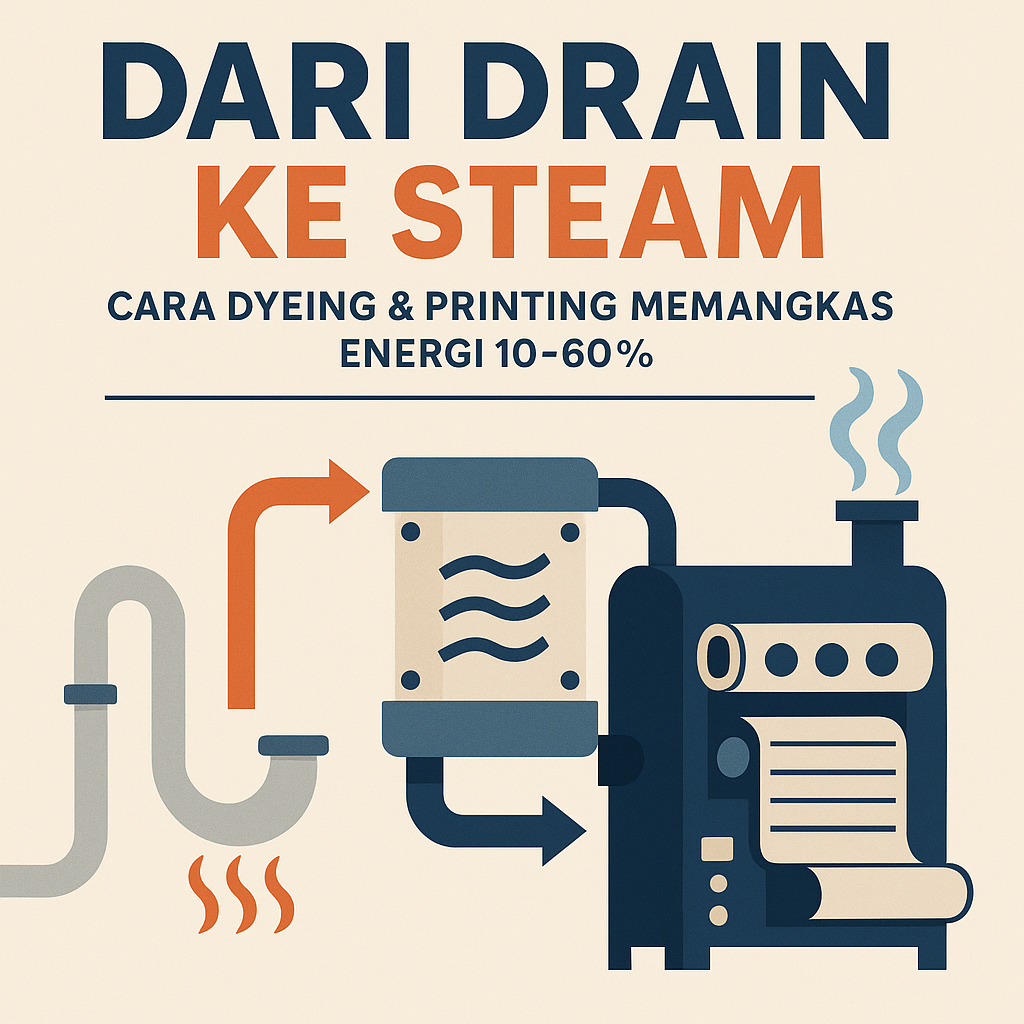Studies show mills can grab double‑digit energy savings by recovering heat from hot wastewater and by switching to room‑temperature reactive dyeing. The data point to quick paybacks and order‑unit cuts in steam use.
Industry: Textile | Process: Dyeing_&_Printing
Textile dyeing is energy‑hungry, and much of that energy leaves the plant as warm water and hot air. One analysis puts heating makeup water at roughly 16.2% of a dye plant’s total production cost (www.mdpi.com). Yet mills often dump that heat: hot‑air fabric stenters (a dryer/heat‑setting machine) can lose ≥90% of input heat, with only ~2.9% of energy going into the fabric (id.vrcoolerar.com), and dyeing effluent (wastewater discharge) is commonly sent out at 50–100°C then cooled before treatment (id.vrcoolerar.com).
The fix is straightforward: a heat exchanger (a device that transfers heat between hot and cold streams without mixing) on the drain, and reactive dyes that work at lower temperatures. Field and simulation studies report immediate, double‑digit gains when plants do either—or both.
Waste‑heat recovery from dyeing lines
Routing hot wastewater through a heat‑exchanger to preheat incoming freshwater slashes boiler demand. Multiple studies show fuel/steam cuts of roughly 10–15% in practice (www.researchgate.net). In one small‑plant case, a simple waste‑heat‑recovery unit cut fossil‑fuel use by up to 10% with payback under 9 months (www.researchgate.net).
Process modeling strengthens the case. Using a reversible exchanger plus a storage tank, one “Case 2” scenario—recovering wastewater above 40 °C—cut the required heating load to 795.5 kW and reduced total heating cost by 63.2% versus a no‑recovery base (www.mdpi.com). Across published experience, energy or cost reductions typically land in the double digits, about 10–60% (www.researchgate.net; www.mdpi.com).
Practical recovery rates and equipment
Commercial wastewater heat‑recovery units claim high capture rates—up to ~90% of wastewater heat—preheating incoming rinse water and sharply cutting steam use (id.vrcoolerar.com). For integration, pinch analysis (a method to match hot and cold streams to maximize internal heat exchange) often proposes many exchangers, but simpler schemes also work: a single heat‑exchanger plus a storage tank underpinned the ~63% cost reduction cited above (www.mdpi.com). By contrast, one direct‑exchange retrofit report needed as many as 15–17 exchangers (www.mdpi.com).
Venting hot air is another missed opportunity. Heat‑setting dryers and stenters blow ~200 °C air through fabrics, then exhaust most of it (id.vrcoolerar.com). Exhaust‑air heat exchangers or condensing systems can recover that energy; one vendor claims about a 90% temperature drop, recouping heat that would otherwise be dumped (id.vrcoolerar.com; id.vrcoolerar.com).
System outcomes and payback windows
Across dyeing and finishing, published cases report energy or cost reductions on the order of 10–60% from wastewater and exhaust heat reuse (www.researchgate.net; www.mdpi.com), with simple systems often earning back their investment in months (www.researchgate.net; id.vrcoolerar.com). Even small heat exchangers or condensers can shrink steam use substantially (www.researchgate.net; www.mdpi.com).
Low‑temperature reactive dyeing
Conventional reactive dyeing (reactive dyes form chemical bonds with fibers; “fixation” is the percentage of dye that binds) typically uses heated baths at 50–80 °C and large salt additions, with low fixation (∼75%), driving multiple hot rinses and high heat consumption (textilevaluechain.in). By contrast, cold pad‑batch (CPB) dyeing applies reactive dyes at roughly room temperature (20–30 °C) with batch fixation. Heating and salt are not needed (textilevaluechain.in).
The savings are material. A European cluster review reports CPB saves about 50% of the total process energy (and water) versus a conventional jet dyeing process (www.clustercollaboration.eu). Higher fixation also translates into fewer washes beyond the initial fixation step (textilevaluechain.in; www.clustercollaboration.eu).
Reactive dyes at 40 °C and below
Specialized reactive dye classes (e.g., dichlorotriazine/vinyl‑sulfone) enable lower‑temperature fixation on cellulose at ~40 °C, and one study “set the temperature to 40 °C” and carried out reactive dyeing at room temperature (pmc.ncbi.nlm.nih.gov). In practical terms, boilers/steam can be turned off—all heating is from room‑temperature addition of caustic or urea (accurate chemical dosing is supported by dosing pumps). The trade‑off is kinetics: low‑temperature fixes often take 12–24 h and require good moisture control, but the energy saving is dramatic. Aside from CPB, any process that avoids upping dye liquor above ~30 °C uses far less steam.
Process energy arithmetic
Key data points from industry sources: reactive pad dyeing runs with roughly room‑temperature liquor, so wash water can stay cold. By contrast, a 60–80 °C dye bath might need ~80–90 °C feed water. Eliminating that heating step can cut a plant’s thermal bill by ~50%. A European cluster case calculated ~50% lower energy and water usage for continuous CPB vs a conventional jet process (www.clustercollaboration.eu). Another industry source notes CPB (ambient) dyeing “reduces energy consumption” by virtue of “room temperature” dyeing (textilevaluechain.in). In short, switching to cold‑fix reactive dyes yields order‑unit energy reductions (tens of % saved). Combined with waste‑heat recovery, it can halve dyeing energy use.
Targets and payback benchmarks

The numbers line up: (a) recovering heat from dye effluent/exhaust can save 10–60% of fuel use (www.researchgate.net; www.mdpi.com), and (b) low‑temperature dyeing (CPB or “cold” reactive systems) can cut energy use roughly ~50% (www.clustercollaboration.eu; textilevaluechain.in). As a concrete target, installing an effluent heat exchanger might trim 10–15% off steam costs, with investment returning in ≲1 year (www.researchgate.net), and adopting cold‑pad reactive dyes can halve hot‑water heating needs (www.clustercollaboration.eu; pmc.ncbi.nlm.nih.gov). Together, these technologies are substantiated by recent studies and industry reports, offering clear, data‑driven strategies to boost dyeing/printing energy efficiency.
Sources and further reading
Peer‑reviewed and industry literature was surveyed. Key references include Seo et al. (2022) on a heat‑recovery system for dyeing (Energies) (www.mdpi.com; www.mdpi.com); Elahee (2010) on heat recovery potentials in textiles (www.researchgate.net); Kanno (1982) on a wastewater heat pump system (www.researchgate.net); Hu et al. (2023) on room‑temperature reactive dyeing (pmc.ncbi.nlm.nih.gov); and European/textile industry analyses on cold pad batch (www.clustercollaboration.eu; textilevaluechain.in).
